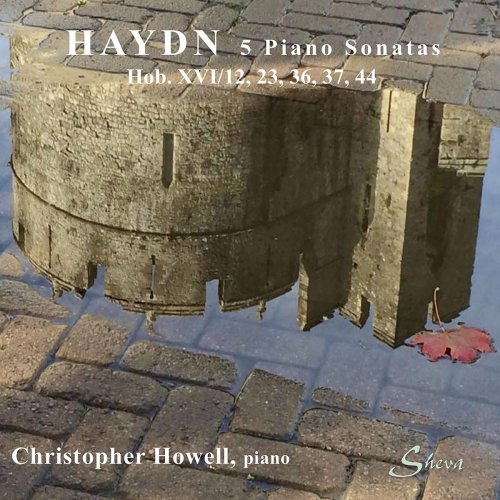
Christopher Howell - Haydn: Piano Works (2020)
BAND/ARTIST: Christopher Howell
- Title: Haydn: Piano Works
- Year Of Release: 2020
- Label: Sheva Collection
- Genre: Classical
- Quality: FLAC (tracks+booklet)
- Total Time: 74:57 min
- Total Size: 270 MB
- WebSite: Album Preview
Tracklist:
01. Divertimento in A Major, Hob. XVI:12: I. Andante
02. Divertimento in A Major, Hob. XVI:12: II. Menuet - Trio
03. Divertimento in A Major, Hob. XVI:12: III. Finale
04. Keyboard Sonata No. 49 in C-Sharp Minor, Hob. XVI:36: I. Moderato
05. Keyboard Sonata No. 49 in C-Sharp Minor, Hob. XVI:36: II. Scherzando. Allegro con brio
06. Keyboard Sonata No. 49 in C-Sharp Minor, Hob. XVI:36: III. Minuet. Moderato
07. Keyboard Sonata No. 38 in F Major, Hob. XVI:23: I. Allegro
08. Keyboard Sonata No. 38 in F Major, Hob. XVI:23: II. Adagio
09. Keyboard Sonata No. 38 in F Major, Hob. XVI:23: III. Finale
10. Keyboard Sonata No. 32 in G Minor, Hob. XVI:44: I. Moderato
11. Keyboard Sonata No. 32 in G Minor, Hob. XVI:44: II. Allegretto
12. Keyboard Sonata No. 50 in D Major, Hob. XVI:37: I. Allegro con brio
13. Keyboard Sonata No. 50 in D Major, Hob. XVI:37: II. Largo e sostenuto
14. Keyboard Sonata No. 50 in D Major, Hob. XVI:37: III. Finale. Presto e sostenuto
01. Divertimento in A Major, Hob. XVI:12: I. Andante
02. Divertimento in A Major, Hob. XVI:12: II. Menuet - Trio
03. Divertimento in A Major, Hob. XVI:12: III. Finale
04. Keyboard Sonata No. 49 in C-Sharp Minor, Hob. XVI:36: I. Moderato
05. Keyboard Sonata No. 49 in C-Sharp Minor, Hob. XVI:36: II. Scherzando. Allegro con brio
06. Keyboard Sonata No. 49 in C-Sharp Minor, Hob. XVI:36: III. Minuet. Moderato
07. Keyboard Sonata No. 38 in F Major, Hob. XVI:23: I. Allegro
08. Keyboard Sonata No. 38 in F Major, Hob. XVI:23: II. Adagio
09. Keyboard Sonata No. 38 in F Major, Hob. XVI:23: III. Finale
10. Keyboard Sonata No. 32 in G Minor, Hob. XVI:44: I. Moderato
11. Keyboard Sonata No. 32 in G Minor, Hob. XVI:44: II. Allegretto
12. Keyboard Sonata No. 50 in D Major, Hob. XVI:37: I. Allegro con brio
13. Keyboard Sonata No. 50 in D Major, Hob. XVI:37: II. Largo e sostenuto
14. Keyboard Sonata No. 50 in D Major, Hob. XVI:37: III. Finale. Presto e sostenuto
Haydn seems to have been sufficiently skilled as a keyboard player to have given lessons on it at various times. Unlike Mozart and Beethoven, however, he made no attempt to parade himself as a virtuoso, or indeed to play in public at all. His piano music suggests, nevertheless, that he valued the keyboard as a private companion, for his music for these instruments has an intimate, conversational and often improvisational tone. This sets it apart from his symphonies, as well as from the sonatas of Mozart and the early-middle period examples of Beethoven, which are more evidently aimed at an audience.
In one sense, Haydn’s keyboard music may seem more old-fashioned than theirs. His model is clearly CPE Bach – he has little time for such modern Italian devices as the Alberti bass, and if there are suggestions of an earlier Italian master, Domenico Scarlatti, these probably reached him through the filter of CPE Bach. He did not necessarily adopt the Fast-Slow-Fast scheme which was fast becoming standard and which Mozart did with very few exceptions – though in truth the earlier works by Haydn that we call sonatas today, were actually called “Divertimenti” by the composer himself. And yet, in their inspirational freedom, Haydn’s sonatas seem to have provided the young Beethoven with a valuable corrective to Mozart’s more orderly world. The sonatas here, though all dating from relatively early in Haydn’s career, contain as many prophetic moments as they do backward leanings.
In one sense, Haydn’s keyboard music may seem more old-fashioned than theirs. His model is clearly CPE Bach – he has little time for such modern Italian devices as the Alberti bass, and if there are suggestions of an earlier Italian master, Domenico Scarlatti, these probably reached him through the filter of CPE Bach. He did not necessarily adopt the Fast-Slow-Fast scheme which was fast becoming standard and which Mozart did with very few exceptions – though in truth the earlier works by Haydn that we call sonatas today, were actually called “Divertimenti” by the composer himself. And yet, in their inspirational freedom, Haydn’s sonatas seem to have provided the young Beethoven with a valuable corrective to Mozart’s more orderly world. The sonatas here, though all dating from relatively early in Haydn’s career, contain as many prophetic moments as they do backward leanings.
Year 2020 | Classical | FLAC / APE
As a ISRA.CLOUD's PREMIUM member you will have the following benefits:
- Unlimited high speed downloads
- Download directly without waiting time
- Unlimited parallel downloads
- Support for download accelerators
- No advertising
- Resume broken downloads


